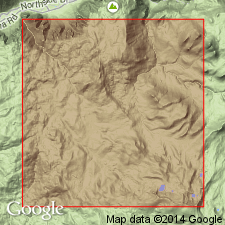
- Usage in publication:
-
- Bridal Veil granite
- Modifications:
-
- Named
- Dominant lithology:
-
- Granite
- AAPG geologic province:
-
- Sierra Nevada province
Turner, H.W., 1899, The granitic rocks of the Sierra Nevada: Journal of Geology, v. 7, p. 141-162.
Summary:
[Named for Bridal Veil Creek]. [no type designated]. Occurs in drainage of Bridal Veil Creek, on Horse Ridge and at many other points in Yosemite Park, CA. [Forms brink of Bridalveil Fall, approx 37 deg 42'N, 119 deg 38'W, Yosemite 15' quad, Mariposa Co, CA]. Is white, rather fine-grained granite showing orbicular structure with central-white quartz and feldspar nucleus surrounded by layer rich in biotite. Intrusive in biotite granite. [Probably Cretaceous].
Source: GNU records (USGS DDS-6; Menlo GNULEX).
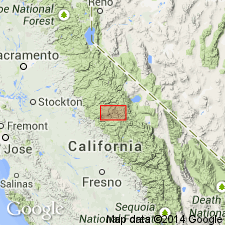
- Usage in publication:
-
- Bridalveil granite*
- Modifications:
-
- Overview
- AAPG geologic province:
-
- Sierra Nevada province
Summary:
Main bodies occur on southern side of Yosemite Valley from vicinity of Taft Point as far west as Crocker Point and at various places in Bridalveil Basin. Is fine-grained pepper-and-salt mixture of feldspar, quartz, and a little biotite whose general tint is very pale bluish gray. Appears to be youngest of granitoid rocks since it cuts all rocks it contacts. Map shows it contacts El Capitan granite, Taft granite, and overlying Quaternary alluvium and talus.
Source: GNU records (USGS DDS-6; Menlo GNULEX).
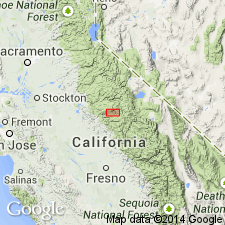
- Usage in publication:
-
- Bridalveil granite*
- Modifications:
-
- Age modified
- AAPG geologic province:
-
- Sierra Nevada province
Summary:
Of the minor intrusive bodies Bridalveil occupies largest area on figure map. Cuts nearly all of several rocks it contacts, especially in Cathedral Rocks and along Bridalveil Creek. Age is Cretaceous.
Source: GNU records (USGS DDS-6; Menlo GNULEX).
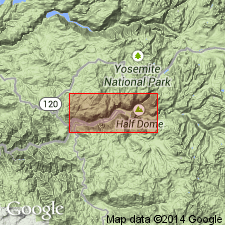
- Usage in publication:
-
- Bridalveil Granodiorite*
- Modifications:
-
- Redescribed
- AAPG geologic province:
-
- Sierra Nevada province
Summary:
[Calkin's (1930)] "map itself remains unchanged but its explanation has been modified. Name Bridalveil Granodiorite used to reflect current IUGS classification used for plutonic rocks. Map shows unit intrudes El Capitan and Taft Granites and diorite of the Rockslides (Cretaceous). Underlies Quaternary alluvium and talus. Assigned Cretaceous age.
Source: GNU records (USGS DDS-6; Menlo GNULEX).
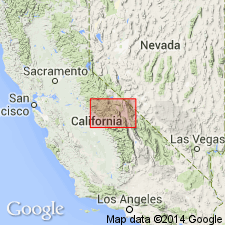
- Usage in publication:
-
- Bridalveil Granodiorite*
- Modifications:
-
- Revised
- Redescribed
- AAPG geologic province:
-
- Sierra Nevada province
Summary:
Name changed to Bridalveil Granodiorite to reflect compositional classification of IUGS (Streckeisen, 1973). Included in intrusive suite of Buena Vista Crest. Forms complex of gently dipping dikes in the vicinity of Bridalveil Falls. Is mostly fine-grained granodiorite. Granodiorite of Horse Ridge is separate unit that forms small pluton in core of granodiorite of Ostrander Lake. Granodiorite of Horse Ridge is darker than Bridalveil Granodiorite. Age considered mid Cretaceous [based on isotopic dating of other units in intrusive suite of Buena Vista Crest].
Source: GNU records (USGS DDS-6; Menlo GNULEX).
For more information, please contact Nancy Stamm, Geologic Names Committee Secretary.
Asterisk (*) indicates published by U.S. Geological Survey authors.
"No current usage" (†) implies that a name has been abandoned or has fallen into disuse. Former usage and, if known, replacement name given in parentheses ( ).
Slash (/) indicates name conflicts with nomenclatural guidelines (CSN, 1933; ACSN, 1961, 1970; NACSN, 1983, 2005, 2021). May be explained within brackets ([ ]).

